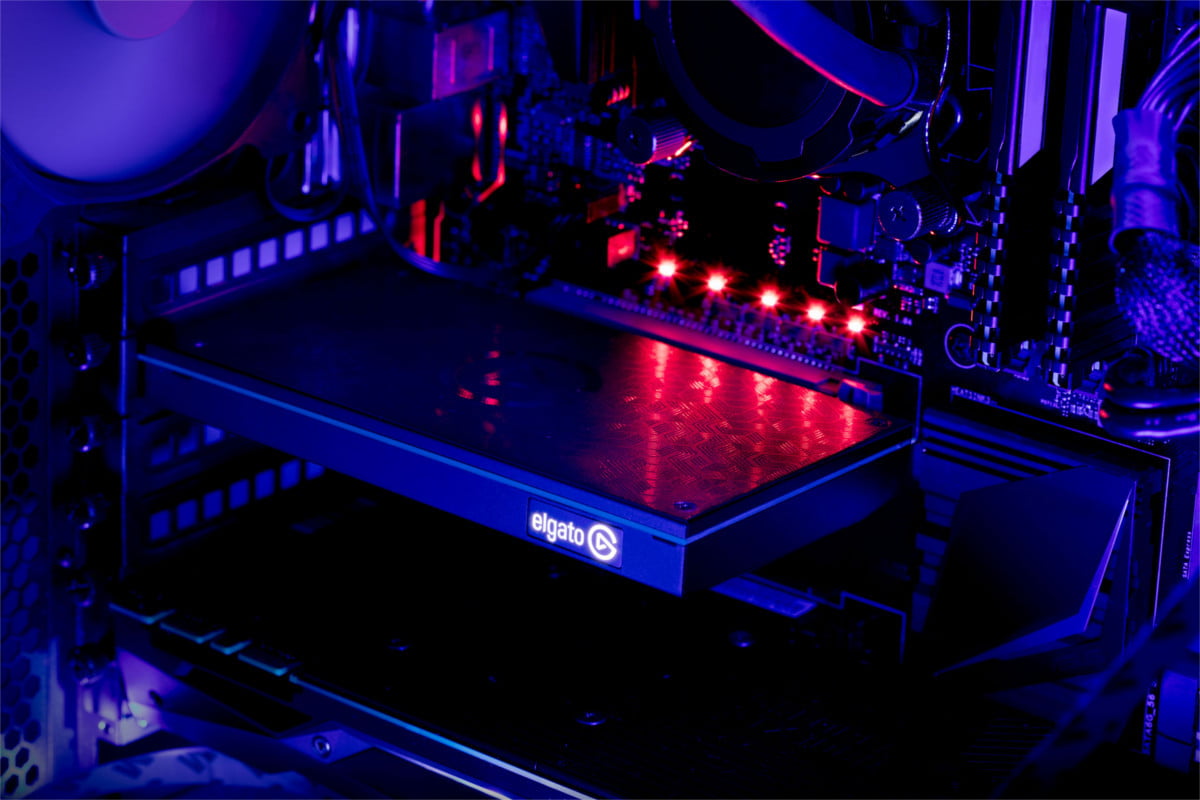A capture card allows you to stream and capture gameplay on PC and consoles without interrupting your gameplay experience. Capture cards serve as a middleman, stealing a feed of your gameplay while you’re playing to record it to your computer or stream it to a platform like Twitch. However, these devices aren’t built equally, so you’ll need one of the best capture cards to record or stream the highest quality gameplay possible.
We’ve rounded up seven capture cards that are great for the PlayStation 5, Xbox Series X, PC, and Nintendo Switch. All of the cards below will work as long as your console has an HDMI port, but we tailored our selections to offer the highest quality possible for their respective platforms.
If you’re interested in a PC capture card, make sure to read our guide on how to build a PC. Some cards only work inside a computer, so you’ll need to learn how to slot in a PCIe card (it’s pretty easy).
Further reading
The best capture cards at a glance
Elgato Game Capture HD60 S+
Pros: Instant streaming, flashback recording, console, PC, and Mac support
Cons: Lacks H.264 encoder, limited editing software capabilities
Elgato’s HD60 is crashing into next-gen with the Elgato HD60 S+. Stylistically and mechanically, it’s almost identical to the HD60 S — our previous recommendation for this slot — though it comes with one unique advantage: 4K60 passthrough with HDR.
Although the HD60 S+ is still limited to 1080p HDR capture at 60 frames per second (fps), you can still monitor your feed with the full graphical fidelity of your new console. The HD60 S+ can capture 4K, too, though it’s limited to 30 fps.
Elgato clearly targeted the Xbox Series X/S and PlayStation 5 with the HD60 S+, but it works on the PS4 and Xbox One, too. No matter what console you’re using, getting set up is simple. After hooking up an HDMI cable to both ends and running the included USB cable to your computer, streaming software like OBS Studio and XSplit will automatically detect your console as an input source.
For system requirements, the HD60 S+ requires a little more than the S variant, but not much. You’ll need a 6th-gen Intel i5 or better paired with 4GB of RAM and an Nvidia GTX 10-series GPU on Windows. On Mac, you’ll still need 4GB of RAM, but you can get by with a 4th-gen i5 or better and either an AMD or Nvidia GPU.
Asus Tuf Gaming CU4K30
Pros: Aluminum body, 4K60 passthrough, RGB lighting
Cons: No 4K60 capture
If you’re looking for a capture card for your next-gen console, the Asus Tuf Gaming CU4K30 is a great option. As the name implies, you can record or stream gameplay at up to 4K resolution at 30 fps. The card also supports 60 fps capture at 2K, as well as 120 fps capture at 1080p.
The passthrough lets you enjoy your gameplay at its full resolution and frame rate, too. You can passthrough up to a 4K signal at 60 fps, or up to 240 fps in the 1080p mode. Asus supports HDR through the passthrough, too.
To keep all of your cables tidy, the card includes a headphone and controller port on the front, so you can easily plug everything in without cords reaching to your console or PC. The capture card connects to your streaming computer with a single USB-C cable, too, which works out of the box. You don’t need to download drivers to start using the card.
Although the looks of a capture card usually don’t matter, the CU4K30 looks great. It’s a tiny, aluminum capture card with an understated Asus Tuf logo on top. It has some RGB underglow, too, which conveniently tells you about different statuses of the cards, such as if the HDMI signal has been interrupted or if the firmware is updating.
AverMedia Live Gamer Portable 2 Plus
Pros: Small and portable, 4K passthrough, the software is versatile and easy to use, records footage to microSD, console, and PC support
Cons: Mac users need third-party software
The Nintendo Switch’s portability makes it a great choice for traveling gamers, and with the right carrying case, you can even take the system’s dock with you. If you want to record gameplay on the go but don’t want to bring a PC, the AverMedia Live Gamer Portable 2 Plus is the best capture card for Nintendo Switch. Although it’s a great capture card for Nintendo’s hybrid console, it also works with PS5, PS4, Xbox Series X, and Xbox One.
With the Live Gamer Portable 2 Plus, you can record gameplay without a tethered PC using its built-in H.264 encoder. It captures in 1080p at 60 fps, which is the ceiling for the Nintendo Switch’s limited capabilities. It saves your video to a microSD card, which you can access through the device’s Micro USB connection to a PC (storage mode) or by transferring the microSD card to a PC.
If you want to livestream gameplay, you’ll need to connect the capture card to your PC and use Avermedia’s software (RECentral). It’s easy to use and comes with features comparable to OBS and XSplit. Live editing allows you to chop down recordings before saving them as a file.
In addition to the microSD and Micro USB ports, the unit provides two HDMI ports along the back, one of which serves as a 4K passthrough (no HDR). Separate microphone and headphone jacks are on the front, along with volume control and mode (PC, PC-free, storage) buttons. The system requirements are a bit strange. With a desktop, you need a Core i5-3330 or better and a GTX 650, while on a laptop, you need a Core i7-4810MQ and GTX 870M or better.
The one major downside of the AverMedia Live Gamer Portable 2 Plus is that its proprietary software only works with Windows. The company offers an “express” version in beta for Macs, but you’ll likely need third-party software like OBS and XSplit.
AverMedia Live Gamer Mini
Pros: Built-in hardware H.264 encoder, live passthrough, 1080p streaming at 60 fps
Cons: Lacking Mac software
The AverMedia Live Gamer Mini is all you really need for streaming, and at $100, it’s cheap, too. It supports 1080p recording and streaming at 60 fps, and the card comes with zero-lag passthrough, allowing you to monitor your gameplay in real-time. In some ways, the Live Gamer Mini even beats out capture cards that are twice its price.
That’s mainly thanks to its H.264 hardware encoder. Like the increasingly rare Elgato HD 60, the Live Gamer Mini takes the encoding workload off your CPU when streaming or recording. Because the card handles encoding, you can even capture backup recordings of your stream with StreamEngine. StreamEngine is a lightweight application included with the Live Gamer Mini, allowing you to capture your gameplay before it heads to your broadcasting software of choice.
Like the Live Gamer Portable 2 Plus above, this capture card comes with AverMedia’s RECentral software. With scene transitions, chroma key support, and an audio mixer, RECentral has everything you need to stream to YouTube, Twitch, Facebook, and more. If you prefer a different broadcasting software, the Live Gamer Mini supports XSplit, OBS, and OBS Studio, too.
Outside of software, the Live Gamer Mini is straightforward. The card is extremely small, clocking in at less than an inch thick, and comes with only three ports: HDMI input, HDMI output, and USB 2.0 output. For system requirements, you’ll need an Intel i5-3330 and GTX 650 or better on desktop and an i7-4810MQ and GTX 870M or better on a laptop. The card requires 4GB of RAM on laptops and desktops, though AverMedia recommends 8GB.
As was the case above, though, Mac users only have access to the express version of RECentral. The AverMedia Live Gamer Mini still comes with chroma key support and the audio mixer, though it lacks live editing and the performance optimizations featured in the full Windows version.
Elgato 4K60 Pro
Pros: HDR support, 4K recording at 60 fps, multi-app support
Cons: Expensive, PCIe only, high system requirements
The Elgato 4K60 Pro is a capture card to end all capture cards, and it comes with a price tag to match. As the only internal card on our list, the 4K60 Pro benefits from much larger bandwidth thanks to its PCIe x4 interface, outracing USB 3.0 in every circumstance and making USB 2.0 look like a relic.
Of course, the standout feature for the 4K60 Pro is that it can record at 2160p at 60 fps. It also supports 1080p60, as well as HDR10.
This is a PC gamer’s capture card, though. Although slotting a PCIe card into your computer is no tough task, simply opening the side panel may be too much. If you fit in that camp but still want the best in quality, our next pick is perfect for you.
The 4K60 Pro is not only a PC gamer’s capture card because it’s internal but also because it demands some pretty hefty system requirements. You’ll need an Nvidia 10-series GPU, at least, as well as a 6th Gen Core i7 or Ryzen 7. It only supports Windows, too.
Thankfully, the Elgato Elgato 4K60 Pro is worth the hassle. It includes the same excellent features seen on the HD60 S, including Flashback Recording, as well as passthrough at up to 1080p240 or 1440p144.
Elgato Game Capture 4K60 S+
Pros: Hardware H.264/H.265 encoding, built-in SD card reader, HDR support, 4K recording at 60 fps
Cons: Very expensive, no high-resolution passthrough
The Elgato Game Capture 4K60 S+ is, basically, a 4K60 Pro in a box. Nearly twice the price on the PCIe variant, the 4K60 S+ clocks in at a staggering $400. It does, however, have some perks over the base 4K60 Pro.
Namely, the S+ comes with an H.264/H.265 hardware encoder built in. You don’t need a supercomputer to use it, as all of the processing takes place on the card itself, but you’ll still need a decent rig. Like the 4K60 Pro, you’ll need a Windows 10 machine with 8GB of RAM and a 10-series or better Nvidia GPU. The CPU requirements are less strict, requiring either a Ryzen 7 or 6th Gen Core i5 or better.
With the encoder on board, you don’t even need a PC to use the 4K60 S+. With the built-in SD card reader, you can easily capture gameplay free of a PC, all at 4K60. Plus, the 4K60 S+ supports HDR in case you want to show off your Xbox One X or PS4 Pro.
There are some cons to going external, though. The 4K60 S+ doesn’t support high-resolution/frame-rate passthrough like the PCIe version, and “Instant Gameview,” a feature we’ll touch on in a moment, is delayed by 250 milliseconds. Still, the 4K60 S+ is an absolute house when it comes to capturing your gameplay at the highest resolutions and frame rates.
AverMedia Live Gamer Duo
Pros: Two HDMI inputs, HDR support, 4K60 passthrough
Cons: No 4K recording, expensive
All of the capture cards above only come with a single input and a single output, so you can only ever stream or record a single source at once. The AverMedia Live Gamer Duo, on the other hand, allows you to record two sources at the same time. Even better, you can record or stream a full 1080p signal at 60 fps from both sources.
So, if you aren’t content with your webcam, you can hook up a DSLR to the second input to add some polish to your stream. You’ll want to hook up your camera to the second input, though. The first input on the card supports HDR, so you can capture HDR gameplay on the PS4 Pro and Xbox One X.
The card is pricey at around $250, and it’s a PCIe card, so you’ll need a free spot on your computer. Compared to cards in the same price bracket — namely the Elgato 4K60 Pro — the Live Gamer Duo doesn’t support 4K recording or streaming. It does, however, support 4K passthrough at 60 fps, so you can still enjoy the full graphical fidelity of whatever game you’re playing. If you favor frame rate over resolution, you can also passthrough a 1080p stream at up to 240Hz or a 1440p at up to 144Hz.
Unlike the AverMedia cards above, the Live Gamer Duo doesn’t have a hardware H.264 encoder, so you’ll need a decent PC to use it. In addition to a free PCIe slot, the Live Gamer Duo requires a sixth-generation i5 or first-generation Ryzen 5 and a GTX 1050 or R7 560 or better. You’ll also need 8GB of RAM.
For software, the AverMedia Live Gamer Duo includes AverMedia’s RECentral software, though it also supports just about every other broadcasting software available. The card comes with RGB lighting on the side, too, allowing you to light up your card with whatever color you want.
EVGA XR1
Pros: Built-in audio mixer, 4K passthrough, ARGB LEDs
Cons: A little expensive at full price
The EVGA XR1 launched in 2020 to mixed reception. With a high price and vague features, many early adopters felt they didn’t get their money’s worth. However, EVGA has already started marking down the XR1, and at its current price of around $100, it’s a great option.
It’s capable of recording and streaming at 1080p at up to 60 fps, and it features 4K60 passthrough. The big point of confusion was EVGA’s advanced passthrough mode. In this state, the EVGA XR1 is capable of 1440p passthrough at up to 120 fps. That means you can enjoy the high frame rate modes on the PS5 and Xbox Series X without disconnecting your capture card (though keep in mind that recording is still limited to 1080p60).
The XR1 also comes with a built-in audio mixer, allowing you to easily control game volume, mic volume, and party chat. Surrounding the mixing knob, the XR1 features an array of ARGB LEDs that can show your audio levels and provide a little visual flare while you’re playing. You can customize the LEDs and manage your audio controls with the included EVGA XR1 software.
EVGA doesn’t list any system requirements, but you shouldn’t have any issues with a laptop or desktop from the past few years. You will, however, need a USB 3.0 port for connecting the XR1 to your computer.
The EVGA XR1 is a great capture card at its current asking price, offering multiple passthrough modes and an intuitive audio mixer. At full price, however, there are better options.
Frequently asked questions
How to use a capture card
Using a capture card is pretty simple. It sits between whatever system you’re playing on and your screen, stealing a copy of what’s going to your screen. In most cases, that means an HDMI cable going from your console or PC to the capture card, and then another HDMI cable going from the capture card to your TV or monitor.
Then, there’s usually a USB cable that connects that capture card to your PC. Once everything is hooked up and powered on, you can add the capture card as an input device in streaming/capturing software, such as OBS Studio.
How to choose a capture card
Choosing a capture card is actually fairly easy, as long as you know what to look for. The most important spec is the maximum resolution and frame rate the capture card supports. If you’re using a PS5 or Xbox Series X, especially, it’s important to pick up a capture card that can deliver the full resolution and frame rate of your console. If you’re just streaming gameplay, not capturing it, you can get by with a lower resolution (streaming at 4K consistently is still a few years off).
Then, there’s the connection method. Five of the seven options above connect via a USB cable, but some use a PCIe connection. PCIe capture cards slot into an open space in your PC, and although they look different, they perform the same function. The only difference is that PCIe has more bandwidth than USB, making PCIe capture cards ideal for capturing lossless or near-lossless gameplay.
Finally, consider the passthrough. Your capture card may limit the resolution and frame rate of your games, depending on what the passthrough supports. The Elgato Game Capture HD60 S+, for example, supports 4K passthrough at 60 fps, allowing you to enjoy the full resolution of a PS5 or Xbox Series X while streaming or recording.
Do you need a capture card?
Although the PS5 and Xbox Series X can capture gameplay internally, it’s best to use a capture card. Not only will a capture card allow you to set up your stream how you want with programs like XSplit and OBS, but it will also allow you to capture higher-quality gameplay.
Without getting too technical, video encoding is extremely demanding on a system’s processor, and capturing gameplay internally usually leads to lower quality encoding. That’s why, if you can record at higher resolutions, you can usually only record for a certain period of time.
A capture card solves that problem, allowing you to customize the quality of your gameplay, as well as record for longer and at higher resolutions. A good capture card is essential for streaming, too, providing you with the full quality of the game you’re playing while handling the streaming separately.


